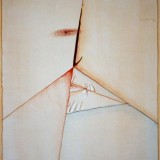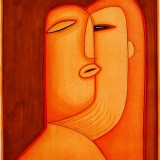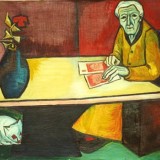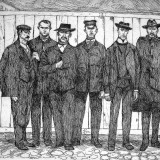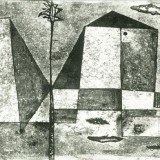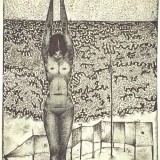Leszek Rózga
Leszek Rózga (born 1924 in Zgierz) is an artist working in the media of painting, drawing, graphics and graphic design.
His studied in Łodź at the Art College and in Katowice, where he continued his studies at the Department of Propaganda Graphics, which was a branch of the Academy of Fine Arts in Kraków (1948-1954). The artist met important figures at the Art College in Łódź – such as professor Adam Rychtarski, Stefan Wegner, Ludwik Tyrowicz, and Władysław Strzemiński. He was also in touch with Władysław Strzemiński after he was fired in 1950. The artist defended his diploma work in 1954 under the supervision of prof. Rafał Pomorski (painting) and Bogusław Górecki (book graphics).
His works from that time are illustrations from current events. The series Repatriates from 1954 consists of portraits – realistic and accurate when it comes to the heroes’ state of mind as people starting new lives full of fears and hopes. The portraits are done with fast, strong strokes, which precisely expose the character of the portrayed. In the mid-50s the artist became engaged in the activity of the Polish Visual Artists’ Union in Łódź. He did a series of paintings and monotypes which referred to Zgierz – his family town. The artist readily uses oil paint and his works created in ink (for example from the series entitled Yard) are fresh and grasp reality in a reportage style.
In 1956 Leszek Rózga participated in the exhibition of “the Eight” with S. Fijałkowski, L. Kowalewicz, L. Kunka, K. Liberska, B. Liberski, J. Nowosielski and J. Urbanowicz. The exhibition was organised in the Łódź Art Propaganda Centre and was the first exhibition of young artists who had escaped from social realism and a traditional formal style after the war. His paintings from that time are characterised by saturated, clear colour, slight deformations and a play with geometrisation of the space. There also appear portraits of the artist’s daughter Małgorzata. In 1958 the artist joined the Fifth Wheel group, which gathered painters and poets, in which artists such as T. Tyszkiewicz, S. Fijałkowski, J. Nowosielski were active. The interest of the group concentrated on the search for modern language of visual and literary expression. He had his first individual show in the 60s (the BWA Gallery in Łódź). The artist’s brush stroke became then a bit softer and one could see the departure from realism. The artist started to use metaphors and created in slightly oniric mood, which often made the viewer anxious. He then created the series Ruins and Relics.
The artist experienced the world while travelling. Moving around, getting to know new places, different landscapes and inspiring people will always be something important for him. The road and experiences associated with it are reflected in the series which emerged through the entire life of the artist. After his trip to Hungary in 1961 the series of drawings Hungarian sketches emerged – it was a fast registration of an interesting place, landscape and situation. At the same time the artist continued to work upon the series Ruins and Relics. In his graphics there is a certain anxiety, fear, and cloudyness. Maybe it’s an echo of the wartime experiences of the artist who was taken to Rurh Coalfield where he was forced to work for the entire war.
In 1967 Leszek Rózga started to work as a teacher in the Art College in Łódź. He worked on the development of the school together with S. Fijałkowski and R. Artymowski and led the new Department of Graphics, opened in 1971. He was a deputy dean and then he ran the Faculty of Graphics.
The artist has been recognised in Poland and internationally. He was invited to exhibit his graphics in Lugano, Germany, Czechoslovakia and Sweden among other places. In 1964 he had his first individual show in Vienna. He then started his series Apparitions and Infinities. He was able to master the space of the sheet of paper or canvas as he deformed and twisted but never crossed the line into abstraction. He still developed metaphor and in his works melancholic and surreal poetics dominated. At the end of the 70s he travelled to Florence, Norway and Italy. The artist received many prestigious awards and decorations – for example the Award of the Ministry of Culture for achievements in graphics (1971) or the Golden Cross of Merit (1975).
In 1977 he started his series Landscapes that he was creating till 1997. The artist operates with a metaphor and allusion, referring to the tradition of painting which he will always treat as an inspiration and the source of his creatively shaped topics and motifs. His masterly brush stroke extremely precisely extracts shapes, nuances and details. The artist continued to work at the art school and taught drawing at the Department of Graphics in the Art College in Łódź. In 1979 he received the title of professor.
The 80s including trips (Spain, Denmark) and a new series of artworks. In 1982 emerged the series Quixotry shown later in Łódź during the exhibition My Spain, and later (1986) Dulcineada.
In 1990 in the 86 Gallery in Łódź works from the series Erotics were presented. The works prove rapacious with an unbridled joy of life and a sensuality is here connected with life energy and power. The artist is fascinated by the ancient world, many times he “re-tells” the stories of heroes of mythology. In 1992 he created the series entitled Egea. The culture of the Mediterranean Sea is a starting point for his subtle, colourful impressions. In 1994 Leszek Rózga finished work at the art school he continued his trips and became interested in Etruscan art. His stay in Tuscany inspired him to create a series of expressive, synthetic landscapes. What is most characteristic in nature, Italian landscape was underlined with a strong, clear form. A clarity and an ability to generalise made these works entirely complete. At the end of 90s the artist focused on the issue of man, his place in the world and the role he has to fulfil. The artist also travelled to Israel and created a series From the Holy Land and The man and people.
Leszek Rózga’s art is inspired by travelling around the world and experiencing the unknown. He travelled around Sicily (Siciliana series, 2000) and Poland (series Bieszczady and Cavalcade). In 2003 there emerged the series Play and players, Trial and Wonderful garden. The artist willingly joins various graphic techniques with paint, crayon and aquarelle which gives very interesting, often surprising effects. Usually he uses clear, intensive and despite that – harmonious colour. In 2005 he devised the series of graphics entitled Abysses and Visions.
He created his later works after his trips to Venice (series entitled Venice), north Germany (series entitled From the Uznam Island) and to Crete (series entitled Crete) and in 2008 he made graphics for the series Faces and profiles. The death of his wife in November 2008 caused him to make a series entitled In an emptiness and Nightmares and his most recent graphics concentrate on full and mature experience of life. He created works devoted to motherhood (Mothers series) and to his closest family (Bruno series).
Leszek Rózga is an artist of a very broad spectrum of artistic expression. He values tradition and looks at it as a main reservoir of topics and stories which he shapes creatively and individually. With his works he comments upon experiences associated with discovering new places, people, landscapes and the feelings and moods which come from them. A poetic atmosphere is what we can find in many works of the artist. Leszek Rózga’s art is saturated with memories which refer to the war and the pre-war reality of Jewish towns and people who have passed away. The artist is also able to criticise the world. He first ridicules and then adds ironic and humorous comments. Leszek Rózga has had about 160 individual and around 500 group shows in Poland and abroad.
Marta Wlazeł
more at the artist's web site:


